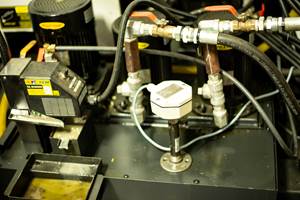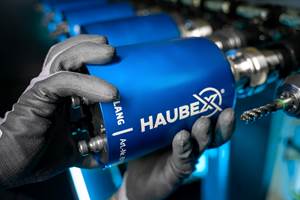It's A Machine Tool Robot
This machine has a dual identity. It looks like an industrial robot. In some applications, such as assembly, it is. However, put a spindle and cutting tool on the end of this five-axis machine and it becomes a machining and drilling center. The inherent stiffness of the machine's tripod design makes it accurate enough to machine aerospace and automotive applications.
Share





This machine has a dual identity. It looks like an industrial robot. In some applications, such as assembly, it is. However, put a spindle and cutting tool on the end of this five-axis machine and it becomes a machining and drilling center. The inherent stiffness of the machine's tripod design makes it accurate enough to machine aerospace and automotive applications.
The machine's manufacturer, Neos Robotics, (Taby, Sweden) has named it Tricept. JMC Technology Group, Inc., (Indianapolis, Indiana), is the U.S. importer for the machine. It is available in two models, the TR 600 and the new, larger TM 805.
The first version of this machine tool, the TR600, was developed about five years ago. Its original purpose was for precision assembly applications. Shortly after these machines found work in assembly, it was discovered that they could do very nicely in light milling and drilling applications especially in environments where high flexibility was a requisite.
The business end to the machine is a tripod formed by three servo actuators. These are pre-loaded to be backlash free. At the upper end, each of the three actuators is supported by a universal joint to aid in freedom of movement. At the lower end is a pre-loaded ball joint with three-degrees of freedom. The upper end of the actuators is supported by a hexagonal cast iron frame. The frame is supported by a column-like structure that is tied to the machine base. The overall machine configuration resembles the well-known C-frame machining center design.
The three actuators guide a central, rigid tube that attaches to the hexagonal frame via a universal joint in its center. A gearbox is integrated in this tube and transmits 590 ft/lbs of torque to manipulate the four or five-axis wrist. In its current design, the machine carries an Ibag 60 hp, 24,000 rpm spindle.
The high-speed spindle coupled with interpolated path speeds of 3500 ipm, facilitate high speed machining in a variety of aerospace and automotive applications. Acceleration is 2g and accuracy is 0.0004 inch. The machine uses a proprietary direct measuring system to provide positioning feedback. Working envelope for the larger machine is 98 by 98 by 31 inches.
Siemens CNC and drive systems are used on the machine. To be able to control the motion of the Tricept machine, using conventional NC programs, a real-time conversion software package has been developed. Using this conversion, the CNC understands a NC program that shows tool path and calculates the appropriate three-dimensional vector. The control software consequently handles the parameters of the machine's kinematics. Shopfloor programming changes can be done on the CNC which features a PC front end.
More applications for this machine are emerging. It has already been successfully applied in aerospace and automotive industries. Its flexibility for five-sided machining with the design's speed and rigidity make it a candidate for production applications in the power train and turbine industries as well as mold and die applications.
Just because our metalworking vernacular lacks a term that accurately describes this new machine tool, it doesn't mean the industry can't use it. A good machine, applied well, no matter what it's called, can still make a shop money.
Related Content
Same Headcount, Double the Sales: Successful Job Shop Automation
Doubling sales requires more than just robots. Pro Products’ staff works in tandem with robots, performing inspection and other value-added activities.
Read MoreManaging Coolant with Skimmers, Refractometers and More
Bacteria-infected coolant harms machines and sickens machinists. Coolant management technologies like skimmers and automated systems counter this tendency.
Read MoreUsing the Toolchanger to Automate Production
Taking advantage of a feature that’s already on the machine tool, Lang’s Haubex system uses the toolchanger to move and store parts, making it an easy-to-use and cost-effective automation solution.
Read MoreIncreasing Productivity with Digitalization and AI
Job shops are implementing automation and digitalization into workflows to eliminate set up time and increase repeatability in production.
Read MoreRead Next
Registration Now Open for the Precision Machining Technology Show (PMTS) 2025
The precision machining industry’s premier event returns to Cleveland, OH, April 1-3.
Read More5 Rules of Thumb for Buying CNC Machine Tools
Use these tips to carefully plan your machine tool purchases and to avoid regretting your decision later.
Read MoreBuilding Out a Foundation for Student Machinists
Autodesk and Haas have teamed up to produce an introductory course for students that covers the basics of CAD, CAM and CNC while providing them with a portfolio part.
Read More





























